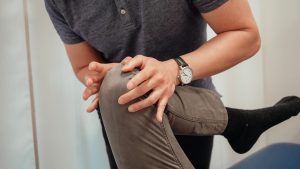What is a total hip replacement/total knee replacement?
Total hip arthroplasty (THA) and total knee arthroplasty (TKA) are common orthopedic surgeries that involve replacing the affected joint with a prosthesis. The most common reason for joint replacement surgery is osteoarthritis, although there are also further health conditions such as rheumatoid arthritis, bone infections, complicated fractures that may also necessitate a joint replacement.
Osteoarthritis is a condition characterized by wear and tear of our bone cartilage over time. Osteoarthritis can cause pain, joint stiffness, and reduced function. If the condition is severely affecting your function and cannot be managed with medications and conservative treatment, your doctor may recommend joint replacement surgery instead.
Hip and knee replacements are highly effective, and those who have the surgery have better mobility, less pain, and can walk more comfortably for up to 25 years after surgery.
What to expect after total hip replacement/total knee replacement?
Depending on your surgeon, different approaches can be used to cut into the joint (incision). Based on the approach, there are certain joint precautions that you may have to adhere to for 6 weeks to 3 months in order to ensure optimal recovery of the joint. Here are the typical precautions associated with the approaches, but ensure to clarify with your surgeon as they may have specific protocols they would like you to adhere to.
Total hip replacement (posterior approach):
- Do not bend your hip more than 90 degrees
- Avoid sitting on low chairs
- Avoid bending down to tie your shoelaces
- Do not cross your affected leg across your midline
- Do not sit with your legs crossed
- Do not turn your affected leg inwards
- Do not twist your body or legs
- Keep a pillow in between your legs while sleeping
Total hip replacement (lateral approach)
- Do not actively bring your leg out to the side
Total knee replacement (all approaches)
- Do not put a pillow underneath your knee as it can quickly become stiff
- Avoid kneeling on your affected knee
Usually, you will only have a short stay at the hospital. With total joint replacements, some patients are able to go home on the same day, while others average a stay length of approximately 2 days. Before you are sent home your medical team will ensure that your pain is well controlled, you are able to move around safely, and your doctor has cleared you to go home.
Total Hip Replacement/Total Knee Replacement Surgery Timeline:
- Day of/after surgery
- Walk with assistance
- Day 1-4
- Leave the hospital
- Day 4+
- Start outpatient physical therapy (physical therapy in the community such as in outpatient private clinics)
- Day 10-14
- Staples removed
- 3-6 weeks
- Walk without walker/crutches/cane
- Return to most daily activities
- 4-6 weeks
- Return to desk jobs
- 2-8 weeks
- Return to driving
- 3 months
- Return to a job with some physical requirements
- 3-6 months
- Gradual return to appropriate sports/recreational activities
Physiotherapy Treatment Plan for Total Hip Replacement/Total Knee Replacement
What is the role of physical therapy after total hip replacement/total knee replacement?

Your journey is not over once you are discharged home! It is important that you continue to do exercises to manage your pain levels, increase your range of motion, and improve your strength to maximize the functional use of your new joint. This is where physiotherapy plays a crucial role in your recovery – a physiotherapist will be able to advise you on the most appropriate exercise to do based on your recovery process. You can start physiotherapy the week you return home, and these services may either be offered as home care, at publically-funded facilities, or private outpatient clinics such as Backs in Action. Typically, BC health authorities will pay for these physiotherapy visits so there are no out-of-pocket fees.
Your physiotherapist at Backs in Action will be able to provide the following tailored interventions to maximize your recovery such as:
- Education on pain management strategies
- Exercise prescription for mobility and strengthening
- Manual therapy
- Assistive aid training (cane, crutches, walker, etc.)
- Stair training
- Balance training
Studies have found that physiotherapy interventions tailored to improving muscle strength, range of motion, and neuromotor control can be effective in helping prevent unfavorable outcomes such as chronic pain or reduced mobility following replacement surgery1. Research has also shown that attending post-surgical rehabilitation produces significant improvements in function and pain when evaluated 3-6 months after replacement surgery2.
After your return home, you should expect to attend physiotherapy sessions 1-2 times per week for 2 to 3 months. By the end of this period, you will have achieved:
- Full mobility at the operated joint
- At least 90% strength compared to the opposite side
- Be walking independently without a limp
- Be able to independently carry out a home exercise program
In addition, regular follow-up visits with medical professionals (including physiotherapists) are recommended for 1-2 years following replacement surgery in order to optimize patient outcomes.
What are some examples of exercises that might be prescribed for total hip replacement/total knee replacement?
Here are some exercises that you may be given after your discharge home following your total hip replacement surgery:
Heel slides:
Start by lying on your back. Slide your heel along the mattress while bending at your knee and your hip, ensuring that your kneecap continues to point upwards to the ceiling. Make sure not to bend your hip past 90 degrees. Hold the position for 5-10 seconds then return to the start position. Repeat 10x, 3x/day, daily.
Glute setting:
Start by lying on your back. Keeping your legs straight, squeeze your buttocks together. Hold for 5-10 seconds then relax. Repeat 10x, 3x/day, daily.
SLR:
Start by lying on your back. Lift your leg up into the sky and hold for 5-10 seconds. Return to start position. Repeat 10x, 3x/day, daily.
Seated knee straightening:
Sit in a chair with good posture. Fully straighten your knee and hold for 5 seconds. Return to start position. Repeat 10x, 3x/day, daily.
Standing hip abduction:
Start by standing on both feet, and holding a counter in front for balance. Move your operated leg out to the side. Keep your hips level, upper body straight, and toes pointing forward. Hold for 5 seconds. Return to start position. Repeat 10x, 3x/day, daily.
Here are some exercises that you may be given after your discharge home following your total knee replacement surgery:
Seated active knee extension:
Start by sitting on a chair with a straight back. Tighten your thigh muscles to straighten your operated knee. Keep your thigh in contact with the chair as you raise the foot (do not let it lift up from the chair). Hold for 5 seconds. Return to start position. Repeat 10x, 3x/day, daily.
Seated knee flexion:
Start by sitting on a chair with a straight back, and place a towel underneath your operated foot. Slide your heel back and under the seat as far as you can go. Hold for 5 seconds. Return to start position. Repeat 10x, 3x/day, daily.
Terminal knee extension:
Place a rolled-up towel under your ankle. Keeping your toes pointed up to the ceiling, press your knee down into the mattress. Place your hands slightly above the knee, and press the knee down into the mattress to further the stretch. Hold for 5 seconds. Return to start position. Repeat 10x, 3x/day, daily.
Mini-squat:
Stand up with your feet shoulder-width apart and your weight spread evenly on both legs. Have a counter or sturdy piece of furniture in front to you to help maintain your balance. Bend your knees slightly while leaning slightly forward. Hold for 5 seconds. Return to start position. Repeat 10x, 3x/day, daily.
Heel raises:
Stand up with your feet shoulder-width apart and your weight spread evenly on both legs. Have a counter or sturdy piece of furniture in front to you to help maintain your balance. Keeping both your legs straights, raise your heels off the floor. Hold for 5 seconds. Return to start position. Repeat 10x, 3x/day, daily.
What is the overall takeaway regarding physiotherapy for total hip replacement/total knee replacement?
There are many exercises and tailored interventions that can be done to maximize functional recovery following a total hip or total knee replacement. Our experienced physiotherapists at Backs in Actions are well aware of the joint precautions in place following your surgery and will be able to advise you on how to progress your exercises safely and gradually. By using a progressive and collaborative approach, we can help facilitate your recovery and return to a meaningful and active lifestyle.
References:
- Henderson KG, Wallis JA, Snowdon DA. Active physiotherapy interventions following total knee arthroplasty in the hospital and inpatient rehabilitation settings: a systematic review and meta-analysis. Physiother (United Kingdom). 2018;104(1):25–35. https://doi.org/10.1016/j.physio.2017.01.002.
- Artz N, Elvers KT, Lowe CM, Sackley C, Jepson P, Beswick AD. Effectiveness of physiotherapy exercise following total knee replacement: systematic review and meta-analysis. BMC Musculoskelet Disord. 2015;16(1):15. https://doi.org/10.1186/s12891-015-0469-6.
Book an Appointment | Call us at 604-876-9977 | Email Us With Any Questions





